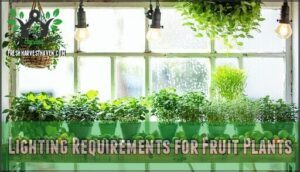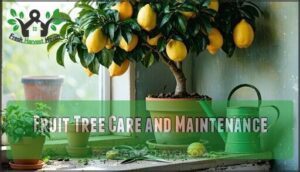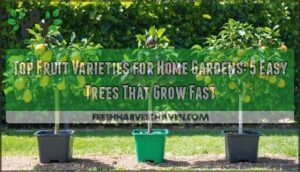This site is supported by our readers. We may earn a commission, at no cost to you, if you purchase through links.

Meyer lemons, key limes, and dwarf oranges thrive in containers with 6-8 hours of daily light from a sunny window or grow light.
Strawberry plants produce year-round harvests, while dwarf pomegranates and figs adapt well to indoor conditions.
Choose self-pollinating varieties that stay compact – they’re your ticket to fresh fruit regardless of outdoor climate.
Success comes down to proper lighting, consistent watering, and selecting the right dwarf cultivars.
The secret lies in understanding each plant’s specific pollination and care requirements.
Table Of Contents
- Key Takeaways
- Easy Fruits to Grow
- Choosing Right Fruit Trees
- Indoor Growing Conditions
- Fruit Tree Care and Maintenance
- Frequently Asked Questions (FAQs)
- What is the easiest fruit to grow inside?
- What is the easiest food to grow indoors?
- What are the quickest fruits to grow at home?
- What is the easiest fruit to grow yourself?
- Can I grow fruit trees if Im a beginner?
- How long until my indoor fruit tree produces?
- Whats the most foolproof fruit for indoors?
- Do indoor fruit trees attract household insects?
- How long does it take for fruit trees to produce?
- Can you grow fruits without natural sunlight indoors?
- Conclusion
Key Takeaways
- Start with dwarf citrus trees and strawberries – they’re the most forgiving for beginners and produce fruit within 4-6 weeks to 2-3 years, making them perfect starter plants.
- You’ll need 6-8 hours of daily light – position plants near south-facing windows or use full-spectrum LED grow lights to ensure proper fruit development and healthy growth.
- Choose self-pollinating varieties – Meyer lemons, calamondin oranges, and most berry plants don’t need partners to produce fruit, eliminating pollination guesswork.
- Use well-draining soil and containers – proper drainage prevents root rot while containers keep plants compact, letting you grow fresh fruit year-round regardless of your outdoor climate.
Easy Fruits to Grow
You can successfully grow fresh, delicious fruits right in your home with the right varieties and basic care techniques.
From quick-producing strawberries to long-term citrus trees, indoor fruit growing offers year-round harvests and beautiful foliage for any living space, providing delicious fruits.
Citrus Fruits for Indoor Growing
You’ll discover that indoor citrus trees are surprisingly manageable and rewarding. These compact powerhouses deliver fresh fruit right to your kitchen counter with minimal fuss.
Transform your home into a citrus paradise with these self-pollinating champions that thrive in containers.
Turn any corner of your home into a fruitful paradise with these container-friendly champions.
Here’s why citrus fruits excel as indoor fruit plants:
- Meyer lemons produce sweeter, less acidic fruit perfect for cooking
- Calamondin oranges offer decorative appeal with small, flavorful fruits
- Dwarf varieties stay compact at 3-5 feet, ideal for small spaces
- Self-pollinating nature guarantees fruit without hand-pollination
- Quick results with fruiting beginning within 2-3 years
Your citrus care routine requires well-draining soil, 8-12 hours of bright light, and consistent watering when topsoil feels dry. Understanding optimal harvest times is essential for maximizing the yield and quality of your indoor citrus fruits.
Tropical and Exotic Fruits for Indoor Cultivation
Three tropical treasures can transform your home into an exotic oasis.
Turn any corner of your home into a thriving fruit sanctuary with these tropical gems.
Avocado Tips start with toothpick-suspended pits in warm water—they’ll need 6-8 hours of sunlight daily. Dwarf fruit trees like bananas require full sun and regular misting for humidity.
Indoor pineapple plant cultivation begins with fresh fruit crowns, demanding direct sunlight for six hours. Fig Varieties such as Petite Negra adapt beautifully to containers, reaching 3-4 feet tall.
These tropical fruit trees serve as stunning indoor fruit plants while you wait 2-3 years for harvest.
Temperate and Berry Fruits for Indoor Growing
Moving beyond tropical options, temperate fruit trees and indoor berry plants offer reliable harvests in controlled environments.
These easy to grow fruits adapt well to container gardening systems.
Top temperate varieties for small fruit plants:
- Strawberry Care requires 6-8 hours daily light for ideal Berry Harvest
- Indoor Apricot trees produce blooms within six months of planting
- Fig Growth thrives in 3-4 foot containers with minimal space requirements
- Blueberries need acidic soil and consistent moisture for fruit development
- Raspberries grow vertically, maximizing yields in compact areas
Monitor for Fruit Pests regularly and maintain proper drainage to prevent root rot in your indoor garden.
Choosing Right Fruit Trees
When you’re selecting fruit trees for indoor growing, you’ll want to focus on dwarf varieties that won’t outgrow your space and self-pollinating types that don’t need a partner to produce fruit.
Compact citrus trees like Meyer lemons, dwarf apple varieties, and small berry bushes work best since they’re bred specifically for container growing and limited indoor environments.
Dwarf Varieties for Indoor Spaces
Dwarf fruit trees transform tight spaces into productive gardens.
Dwarf Lemons and Mini Oranges thrive in containers, while Indoor Avocados and Compact Peaches adapt beautifully to apartment living.
Small Pomegranates add Mediterranean flair to your container gardening setup.
These small fruit plants deliver full-sized flavors without overwhelming your home’s footprint through specialized rootstock grafting.
For successful cultivation, understanding dwarf tree care is essential to maintain their health and productivity.
Self-Pollinating Citrus Varieties
Self-pollinating citrus trees eliminate the guesswork from indoor citrus success.
Meyer lemons and Calamondin oranges feature built-in pollination methods through citrus breeding advances, producing fruit without partners.
These dwarf varieties handle fruit production solo, making nursery selection simpler.
You’ll skip tree grafting complications while enjoying reliable harvests.
Citrus care becomes straightforward when your trees don’t need pollination assistance.
Compact Fruit Trees for Small Areas
You’ll maximize your harvest when compact fruit trees transform tight spaces into productive indoor orchards.
Dwarf fruit trees like Meyer lemons and figs reach just 3-4 feet tall, making fruit selection perfect for small gardens.
These space saving champions deliver full-sized flavor in containers, proving that successful indoor gardening doesn’t require sprawling yards—just smart planning.
Effective small space gardening techniques can substantially increase yields in limited areas.
Indoor Growing Conditions
Creating the perfect indoor fruit garden starts with understanding your plants’ basic needs.
You’ll need to master three key factors: proper lighting conditions, ideal soil and watering practices, and maintaining the right temperature and humidity levels for healthy fruit production.
This involves considering ideal soil and how it contributes to the overall health of your plants, alongside other critical factors.
Lighting Requirements for Fruit Plants
Light requirements can make or break your indoor fruit success. Your plants need precise illumination to produce quality harvests.
Natural Light provides the best foundation – position plants near south-facing windows for maximum Sunlight Hours. Most fruits require 6-8 hours daily, though some show Shade Tolerance.
When Natural Light falls short, LED Grow Lights become your solution:
- Full-spectrum LED Grow lights deliver 2000-3000 foot-candles intensity
- Position lights 12-24 inches above plants to prevent burning
- Use timers for consistent 12-16 hour exposure schedules
- Blue wavelengths enhance fruit flavor development considerably
Artificial Lighting supplements window light effectively. Monitor your plants – leggy growth signals insufficient illumination. Quality grow lights transform any space into a productive fruit garden. For best growth, understanding LED grow options is key for indoor fruit cultivation.
Soil and Watering Needs for Indoor Fruits
Success in indoor fruit cultivation starts with the right foundation.
Choose well-draining soil with proper drainage systems like perlite or pumice stones. Your soil pH should stay between 6.0-7.0 for ideal nutrient balance.
Check soil moisture regularly – water when the top inch feels dry. Water quality matters too; room temperature water prevents root shock.
Monitor moisture levels carefully since overwatering kills more plants than drought. Consider fertilizer types that won’t burn roots in containers.
Understanding the best soil mixes is vital for a healthy and thriving indoor fruit garden.
Temperature and Humidity Control
Creating the perfect environment for your indoor fruit cultivation requires mastering thermal regulation and humidity levels. Most low maintenance fruits thrive between 65-75°F, while tropical varieties need consistent warmth and humidity replication around 50-60%.
Climate control strategies include:
- Use heating systems or heat mats for consistent temperature control
- Install humidifiers or humidity trays for proper moisture levels
- Make certain adequate air circulation with small fans to prevent fungal issues
- Monitor conditions with digital thermometers and hygrometers
These indoor gardening tips create stable microclimates that mimic each plant’s natural habitat, guaranteeing healthy growth and fruit production year-round.
Fruit Tree Care and Maintenance
Successfully growing indoor fruit trees requires proper maintenance throughout their growth cycle.
You’ll need to master three essential practices: pruning and training for ideal shape, fertilizing while managing pests, and repotting when roots outgrow their containers.
Pruning and Training Fruit Trees
Why struggle with unruly indoor fruit trees when proper tree pruning transforms them into productive powerhouses?
Fruit training requires strategic branch cutting and leaf thinning to maximize harvests. Remove dead, diseased, or crossing branches first. Stem grafting isn’t necessary for most indoor fruit trees.
| Pruning Technique | When to Apply | Expected Result |
|---|---|---|
| Branch Cutting | Late winter/early spring | Improved air circulation |
| Leaf Thinning | During growing season | Better light penetration |
| Shape Training | Year-round maintenance | Compact, manageable size |
Mastering pruning techniques is vital for effective fruit production. Master these pruning techniques and your indoor gardening tips arsenal grows stronger. Clean cuts heal faster than ragged tears, keeping your fruit tree care routine simple and effective.
Fertilization and Pest Management
For your indoor fruit trees, proper fertilization begins with balanced organic fertilizers applied every 4-6 weeks during growing seasons. Compost tea enriches soil health while providing gentle nutrition that won’t burn roots.
Effective pest control combines prevention with targeted intervention:
- Weekly inspections catch problems before they spread to neighboring plants
- Natural pesticides like neem oil disrupt pest lifecycles without harming beneficial insects
- Sticky traps monitor flying pest populations and provide early warning systems
- Beneficial predators such as ladybugs control aphid infestations naturally
Fruit tree fertilization supports pest resistance – healthy trees withstand attacks better than stressed ones. Using organic gardening methods can improve overall plant health and resilience.
Repotting and Soil Replacement
Your fruit trees won’t thrive forever in cramped containers. Check for root pruning needs when roots circle the pot’s edges. Choose self watering planters with excellent drainage for repotting techniques.
Fresh soil mix rejuvenates fruiting houseplants every 2-3 years. Indoor fruit trees demand welldraining soil and proper fertilizer use for ideal growth.
| Repotting Schedule | Container Size | Soil Requirements |
|---|---|---|
| Young trees (1-2 years) | 2-4 gallon pots | Standard potting mix |
| Mature trees (3+ years) | 5-10 gallon containers | Well-draining blend |
| Citrus varieties | Self-watering planters | Acidic soil mix |
| Berry plants | Shallow, wide pots | Organic compost blend |
Frequently Asked Questions (FAQs)
What is the easiest fruit to grow inside?
Strawberries top the list as your easiest indoor fruit choice.
They’ll produce sweet berries within 4-6 weeks of flowering, need just basic containers, and thrive with 6-8 hours of daily sunlight or grow lights.
What is the easiest food to grow indoors?
Nearly 80% of households lack adequate indoor growing space.
You can harvest these nutrient-dense plants in weeks using any shallow container, making them your fastest indoor food option.
Microgreens need just two inches of soil depth.
What are the quickest fruits to grow at home?
You’ll get fruit fastest with strawberries—they’re ready in just 4-6 weeks after flowering.
Radishes harvest in about a month, while microgreens can be snipped within days of sprouting for instant gratification.
What is the easiest fruit to grow yourself?
Strawberries are your best bet for indoor fruit growing. They’re low-maintenance, produce fruit within 4-6 weeks of flowering, and thrive in containers with just 6-8 hours of daily sunlight.
Can I grow fruit trees if Im a beginner?
Telegram this to your Victorian ancestors: you absolutely can cultivate dwarf citrus trees and strawberry plants as a beginner.
Start with Meyer lemons or strawberries—they’re forgiving, require basic care, and you’ll harvest fruit within months.
How long until my indoor fruit tree produces?
Most indoor fruit trees take 2-4 years to produce fruit, though some citrus varieties may bear within 1-2 years. Patience pays off—you’ll enjoy fresh homegrown fruit!
Whats the most foolproof fruit for indoors?
Strawberries reign supreme as your foolproof indoor fruit champion.
They’re virtually indestructible, producing sweet berries in just 4-6 weeks after flowering.
You’ll need 6-8 hours of sunlight daily and well-draining soil to prevent root rot.
Do indoor fruit trees attract household insects?
Indoor fruit trees can attract common household pests like fungus gnats, spider mites, and aphids.
You’ll need to monitor soil moisture, provide good air circulation, and inspect leaves regularly to prevent infestations from taking hold, which includes being vigilant about common household pests.
How long does it take for fruit trees to produce?
You’ll wait 2-4 years for most fruit trees to bear fruit. Dwarf varieties and strawberries produce faster, while avocados can take up to a decade to fruit.
Can you grow fruits without natural sunlight indoors?
Breaking free from the sun’s shackles, you can absolutely grow fruits indoors using LED grow lights.
These artificial light sources provide the full spectrum needed for photosynthesis, allowing strawberries, dwarf citrus trees, and other compact varieties to thrive year-round in windowless spaces using full spectrum.
Conclusion
Imagine your home transformed into a year-round orchard where fresh fruit dangles within arm’s reach.
Growing easy fruits to grow indoors isn’t just a gardening dream—it’s an achievable reality with the right knowledge.
Your success depends on selecting proper dwarf varieties, providing adequate lighting, and maintaining consistent care routines.
Whether you’re nurturing citrus trees or berry bushes, these indoor fruits reward patience with continuous harvests.
Start small, stay consistent, and you’ll soon enjoy homegrown produce regardless of season or climate, and find that growing your own fruits can be a truly achievable reality with the right approach to consistent care.









